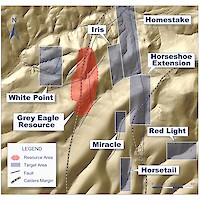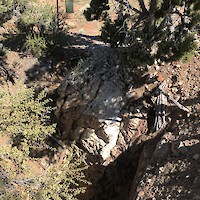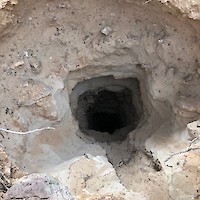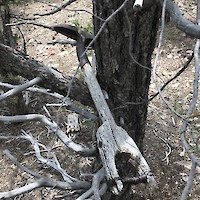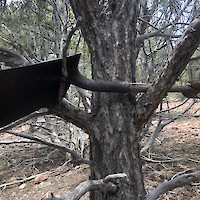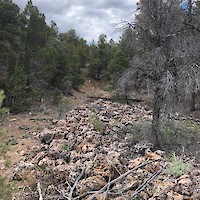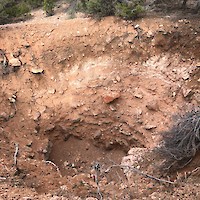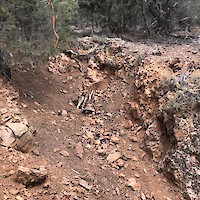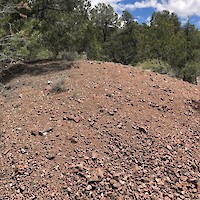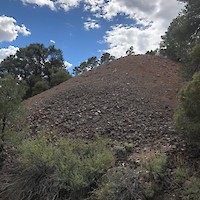System Type:
Low sulphidation, epithermal, banded quartz-calcite veins, with hydrothermal breccia zones
Strike-Length:
The Horseshoe Extension target is a 750 meters section of the major Horseshoe structural zone located between the Horseshoe and Homestake historical mines.
Resource:
None at this time

Location:
The Horseshoe Extension target is located in the Nevada side of the Gold Springs project, just north of the historical Horseshoe mine, which was the largest gold producer in the district, and continues to the southern edge of the Homestake target.
Drilling:
None
Geophysics:
Horseshoe Extension is located along the edge of a resistivity high anomaly identified in the airborne ZTEM geophysical survey at a 135 metre depth slice (see map below).
Geology:
Mineralization at the Horseshoe Extension is characterized by banded quartz-calcite veins and hydrothermal breccia zones that are hosted in silicified andesite. Most of the target is covered by a layer of post-mineral gravel which ranges in thickness from a thin cover to over 10 meters.
Structural Geology:
The Horseshoe historical mine, Homestake and Horseshoe Extension targets are all located along the same major north-south trending fault zone. This structural corridor extends over 7 kilometers in length and represents one of the largest and most dominant structures within the project area, and dominates the Horseshoe Extension target. This structure is well exposed on surface at the southern end, where the Horseshoe historical mine is located, and on the northern end, where the Homestake historical mine is situated. In between lies the Horseshoe Extension target where much of the area is covered by post-mineral gravels. There are numerous historical mine workings scattered along the 750 metre Horseshoe Extension strike-length with several shafts and tunnels showing mineralized material on the dumps.
Historical Mining:
The Horseshoe Mine was a major producer with a reported 39,342 tons with an estimated average grade 10.63 g/t of gold and supported a 100-tons per day mill.
North of the Horseshoe, the north end adit contains approximately 305 meters of workings, with several historical shafts, pits and tunnels to exploit banded quartz-calcite vein systems. The largest historical mine working is a caved tunnel displaying a large dump containing large vein fragments. The Horseshoe and Homestake historical mines were high-grade underground mines that exploited a banded quartz-calcite vein up to 7.5 meters thick. Both these mines are on the same structure.
Geochemistry:
Mineralization at the Horseshoe Extension is characterized by banded quartz-calcite veins and hydrothermal breccia zones that are hosted in silicified andesite. Recent sampling by the Company produced the following results with gold greater than 0.25 g/t Au (cutoff grade of the existing resources at Gold Springs):
Table: Recent Rock Chip Sampling Results from Horseshoe Extension:
|
Sample ID |
Company |
Sample Type |
Description |
Au (g/t) |
Ag (g/t) |
|
224467 |
GRC |
Dump |
Silicified andesite |
1.67 |
3.1 |
|
224472 |
GRC |
Dump |
Silicified andesite with minor veins |
1.52 |
3.5 |
|
224473 |
GRC |
Outcrop |
Silicified andesite with stockwork veins |
0.4 |
1.8 |
|
224475 |
GRC |
Dump, 0.5m by 0.5m area |
Silicified andesite with stockwork veins |
7.85 |
2.4 |
|
224476 |
GRC |
Outcrop |
Old mine pit. Massive quartz-calcite vein |
0.41 |
1.8 |
|
224477 |
GRC |
Dump, 0.5m by 0.5m area |
Breccia |
1.01 |
2 |
|
224487 |
GRC |
Dump, 0.5m by 0.5m area |
Massive white quartz-calcite vein from 10m deep shaft |
1.31 |
4.3 |
|
224489 |
GRC |
Dump, 0.25m by 0.25m |
Silicified andesite with stockwork veining and crystals of green fluorite. |
0.28 |
8.2 |
|
224494 |
GRC |
Dump grab |
Massive quartz vein. |
0.33 |
1.8 |
|
224495 |
GRC |
Outcrop grab |
Fault gouge with hematite and quartz vein |
1.38 |
2.6 |
A cutoff grade of 0.25 g/t Au was used, which is the cutoff grade of the nearby Grey Eagle resource.

